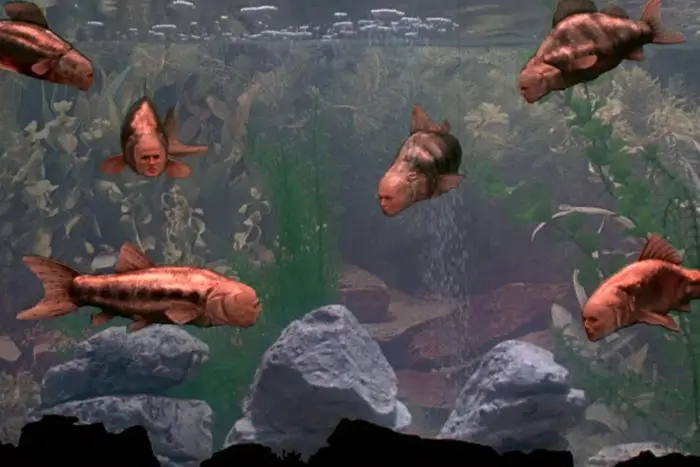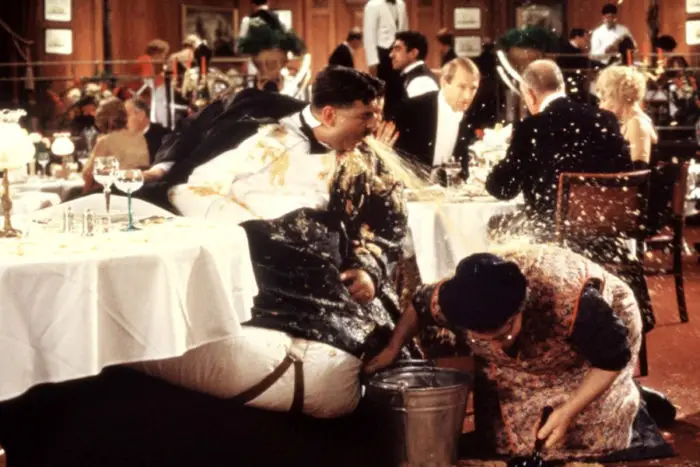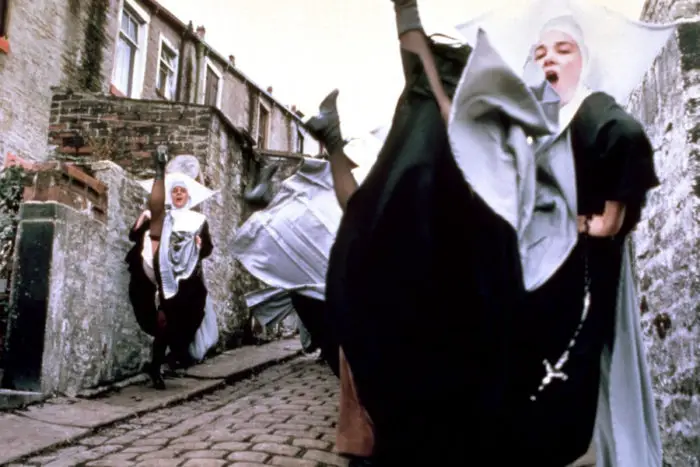The meaning of the film “The Meaning of Life According to Monty Python”, the plot, the explanation of the ending, similar films. What is Monty Python’s Meaning of Life: an analysis of an absurd comedy?
Country: UK
Genre: comedy, musical
Year of production: 1983
Directed by: Terry Gilliam, Terry Jones
Cast: Eric Idle, John Cleese, Graham Chapman, Michael Palin, Terry Jones, Terry Gilliam
tagline: “It took God six days to create the Earth, Monty Python only ninety minutes to mess it up.”
Awards and Nominations: Cannes Film Festival Grand Jury Prize 1983, British Academy nomination for Best Song in 1984
The film “The Meaning of Life according to Monty Python” (“The Meaning of Life”), despite the fact that almost forty years have passed since its creation, and the fact that it is a comedy, can shock and even drive many people into depression. Let’s figure out what idea the authors wanted to convey to the audience.
What is the movie about
The content of the film is a set of sketches, each of which in one way or another relates to the meaning of life.
The prologue is a short story about an insurance agency whose older workers are oppressed by younger managers. The old people start a rebellion, overthrow the bosses and set off to surf the expanses of the “financial seas”, challenging and successfully defeating even bigger bigwigs. However, in the end, their pirate home-ship swims to the ends of the earth and falls into the abyss.
The main part of the film begins with a conversation between anthropomorphic fish that swim in an aquarium and through the glass detachedly watch how a restaurant visitor is about to eat their friend. They talk about the meaning of life, but immediately come to the conclusion that finding it is an extremely difficult task.
 Frame from the film.
Frame from the film.
Next comes an animated screensaver in which the viewer is shown a kind of assembly line for the production of people and clichéd attributes of their well-being. A song sounds, where rhetorical questions are also heard about why we were born and why we live.
In the first part of “The Meaning of Life According to Monty Python”, called “The Miracle of Birth”, the authors show the maternity ward, in which they are preparing for the birth of a child. Everyone treats the woman in labor with obvious disdain and cynicism. Doctors take the child out and throw it like a piece of meat. At the same time, they seem to be proud of their work and the expensive equipment entrusted to them.
In the next short story, a father with many children is forced to hand over his numerous offspring for experiments, since he does not have the means to support them, and he completely refuses contraception, being an adherent of the Catholic Church. The absurdity is heightened by a song about the importance of sperm. Protestant neighbors ridicule the unlucky father, emphasizing in this regard the virtues of their faith.
The second part of “Growing Up and Learning” begins with a mockery of the problem of religion: we are shown a church school in which the emphasis is on the fear of God’s wrath. In the next sketch, a school teacher tells teenage students about sex, and then, together with his wife, demonstrates sexual intercourse.
 Frame from the film.
Frame from the film.
Next up: a brutal game of rugby in which big strong players beat up weak juniors. In the third part, “The War of All Against All”, the game turns into a war, which is the backdrop for the following sketch: the commander cannot launch a counterattack because of the soldiers flooding him with gifts. A military lecturer who talks about the importance of the army is struck by lightning from the pointing finger of God at the words “God strike me if I’m wrong.” Further, another military rank dismisses his subordinates, since they do not want to engage in drill training.
Officers of a British army unit fight the Zulus and die en masse, but the commander worries about a subordinate who lost his leg due to a predator. Under the suit of the latter, however, were hiding two klutzes, the hidden meaning of whose actions remained a mystery to everyone.
In the middle of the film, the authors offer to play the game “find the fish”, in fact demonstrating pure surrealism: people in strange costumes, carrying nonsense. Anthropomorphic fish in the aquarium, looking at this, seem to repeat the thoughts of the audience: “Bravely! But in fact, they didn’t tell us anything sensible about the meaning of life.”
In the fourth part of “Middle Age” we are shown a rich age couple who visits a restaurant where they can choose a topic for conversation on the menu. Conversation on philosophical topics is not given. In the next sketch, there is a bloody scene in which a person’s liver is cut out, because he recklessly agreed to it earlier. The fate of the character is followed by his wife, who succumbed to the persuasion of the “surgeons” after a song about the greatness of the universe and the insignificance of human existence.
The sixth part of “Autumn of Life” shows perhaps the most disgusting scene of the film: a fat rich man chokes on food, continuously vomits and eventually explodes. The rest of the restaurant’s patrons try to escape, trying to keep the rules of decency.
 Frame from the film.
Frame from the film.
The waiter takes the viewer out of town and tells how his mother taught him in childhood that you need to appreciate the world around you and bring joy to people, but then he gets annoyed and leaves.
In the seventh part, called “Death”, a guy jumps off a cliff, running away from naked women. Leaves fall from the tree, which are voiced as if they are living people committing suicide. Death with a scythe takes the aristocrats, poisoned by fish, to a paradise that looks like a cabaret. In the end, the female TV presenter declares the supposedly true meaning of life according to Monty Python: “Be polite, do not eat fatty foods, read good books, walk more often, live in peace and harmony, regardless of nationality and religion.”
The meaning of the film
The description of the plot is consistent and at the same time chaotic and absurd. Considering that Monty Python’s The Meaning of Life was actually directed by several members of the comedy troupe at once, constantly entering into disagreements with each other, this is not surprising. The parts of the film and their interpretations do not have to form a whole picture. Although the unity of the approach can be traced – each author with the same zeal mocks the institutions of human society: the school, the army, the church, the family.
It is unlikely that individual sketches require careful analysis and detailed explanation. Everything is quite simple and does not carry any hidden meaning – cynicism and sarcasm rule the ball. The miracle of birth is not actually a miracle, but is a gross manifestation of the material world.
 Frame from the film.
Frame from the film.
In the process of growing up and learning, no one becomes more mature and smarter: after a useless school, people go to the mouth of the war, the essence of which is voiced by one of the characters: “I killed fifteen people. At home they would hang me, but here they will give me a medal.” Further, the focus of attention switches to mature wealthy people (a couple in a restaurant) who enjoy luxury, but whose intellectual abilities are extremely small.
Having lived a significant part of their lives, they are not able to talk about any spiritual spheres. Another family is no better. One, apparently, having become a victim of advertising and his own greed, lost his liver and life. His wife also went under the knife, trusting in fairy tales about the infinite greatness of the universe.
Another representative of the bourgeoisie is a living embodiment of the cult of consumption: he greedily eats endlessly, unable to stop. This eventually leads to his death. A simple hardworking waiter seemed to remember the wise words of his mother, but then, in irritation, he drove uncomfortable thoughts away from himself. Death is also presented as a farce. And the long-awaited paradise is a ridiculous cabaret, reflecting the narrow-minded ideas of the townsfolk about it.
Questions can only be raised by the game “find the fish”, which actually has no clue: this is surrealism for the sake of surrealism, strangeness for the sake of strangeness. And a little more does not fit into the general outline of the prologue about the old pirates.
However, if you think about it, there is a connection with the rest of the plot: this is a parable about those who, towards the end of their lives, discovered that they had not achieved so much, and decided to make up for lost time (battle with young financiers), but after that they still came to an incomprehensible and ridiculous death (falling into the abyss). The fish in the aquarium are designed to beat the reaction of the audience, showing that the authors foresaw it.
Ending explanation
At the end of the mouth of the female character are words that should reflect the essence of the film. But this, of course, is a snag: if the authors had agreed with their heroine, the picture would have been completely different. Her words about politeness, harmony and a healthy lifestyle are correct and banal. And the meaning of life according to Monty Python, of course, is not. This is nothing more than a set of rules, a brief extract from spiritual teachings. And the authors seem to be purely materialists.
The point of Monty Python’s The Meaning of Life ending is to break expectations. The creators of the picture, as it were, say: “Did you really expect any revelations from us?” The viewer is faced with a harsh reality: no one, except himself, will give a clue to the meaning of life.
Everything that others teach with a smart look is nonsense. Although, of course, it is easiest to let teachers, commanders, priests decide for you what to do. This explanation of the ending is quite in tune with the entire previous plot and the tone of the story.
 Frame from the film.
Frame from the film.
Similar films
- “Monty Python: The Flying Circus” (UK, 1969 – 1974): a collection of sketches by a comedy troupe.
- “The discreet charm of the bourgeoisie” (France, Spain, Italy, 1972): a sketch in a surreal style dedicated to the worthless life of the rich.
- The Man Who Killed Don Quixote (Spain, Portugal, UK, 2018): Monty Python member Terry Gilliam’s dream project on the nature of vanity.
- Rick and Morty (USA, since 2013): an animated series about the adventures of a brilliant scientist and his grandson – a concentration of cynicism and sarcasm comparable to Monty Python’s The Meaning of Life.







